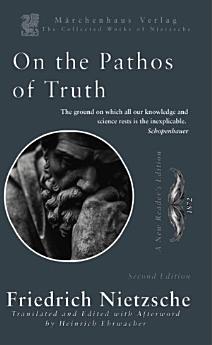On the Pathos of Truth: A New Reader's Edition
May 2024 · The Collected Works of Friedrich Nietzsche Book 20 · Marchen Press
Ebook
104
Pages
family_home
Eligible
info
reportRatings and reviews aren’t verified Learn More
About this ebook
Nietzsche's 1872 "Über das Pathos der Wahrheit" was originally a preface to a book which he never wrote. In 1873, Nietzsche bound this and four other prefaces in a leather-bound copy and gave it to Cosima Wagner (the second wife of his later arch-enemy Richard Wagner) on New Year's day, 1872 as a present. This handwritten edition, which he titled "Fünf Vorreden zu fünf ungeschriebenen Büchern. Von Friedrich Nietzsche". The original copy is held in the Goethe- und Schiller-Archiv in Weimar, Germany. This archive is the oldest literary archive in Germany and houses an extensive collection of manuscripts, including a significant number of Nietzsche's works. The prefaces that comprise it were also published in 1901 by sister's foundation dedicated to publishing and preserving Nietzsche's works, Elisabeth Förster-Nietzsche. This and the other fragments from his estate were then re-published in various formats after that -including in a series titled "Gesammelte Werke" (Collected Works), later reorganized and expanded into the "Gesamtausgabe" (Complete Edition), which included comprehensive collections of Nietzsche's notebooks and other writings from various periods of his life. Nietzsche's "On the Pathos of Truth" is a meditation on the nature of truth, the role of the philosopher, and the existential implications of the pursuit of knowledge. Core to this short essay is the examination of transience and eternity. He contemplates the inherent human consternation at the impermanence of profound moments and achievements, and presents this consternation as a moral confrontation with the nature of existence itself. Nietzsche has a disdain for "normal" society, and critically dissects the prevailing cultural practices that stifle and obscure greatness and heaps philosophical scorn on the mediocrity that populates the world. This is a central attitude to his idea of the Übermench. His depiction of cultural struggles highlights a philosophical vanguard, a solitary journey of existential loneliness that philosophers must endure in order to arrive at truth. Art, then, has an alchemical role in human life, Art and Philosophy transcends mere cognitive recognition. Art and philosophy thus emerge not only as conduits of truth, but also as necessary illusions that make life bearable. In keeping with his love of Pre-Socratic philosophers. He spends time on Heraclitus to prove that those who seek truth end up in loneliness This Critical Reader's Edition offers a modern translation of the original manuscript, designed to help the armchair philosopher engage deeply with Nietzsche's works. The translation features clean, contemporary language with simplified sentence structures and diction, making Nietzsche's complex ideas more accessible. In addition to the main text, this edition includes extensive supplementary material that enhances the manuscript with autobiographical, historical, and linguistic context. It contains an afterword by the translator examining the history, impact, and intellectual legacy of Nietzsche in relation to this work, an index of philosophical concepts with emphasis on Existentialism and Phenomenology, a complete chronological list of Nietzsche's published writings, and a detailed timeline of his life, highlighting the personal relationships that significantly shaped his philosophy.
About the author
Friedrich Nietzsche (1844-1900) was a watershed German philosopher, cultural critic, poet, musician (briefly) and philologist (the study of ancient manuscripts) whose work has had a profound impact on modern intellectual history. Known for his critiques of European morality and religion (particularly Protestantism), Nietzsche's ideas on the "will to power" and the "Übermensch" have influenced a wide range of philosophical, literary, and psychological thought including thinkers such as Martin Heidegger, Albert Camus, Michael Foucault and the entire Postmodern religion.
Rate this ebook
Tell us what you think.
Reading information
Smartphones and tablets
Install the Google Play Books app for Android and iPad/iPhone. It syncs automatically with your account and allows you to read online or offline wherever you are.
Laptops and computers
You can listen to audiobooks purchased on Google Play using your computer's web browser.
eReaders and other devices
To read on e-ink devices like Kobo eReaders, you'll need to download a file and transfer it to your device. Follow the detailed Help Center instructions to transfer the files to supported eReaders.











